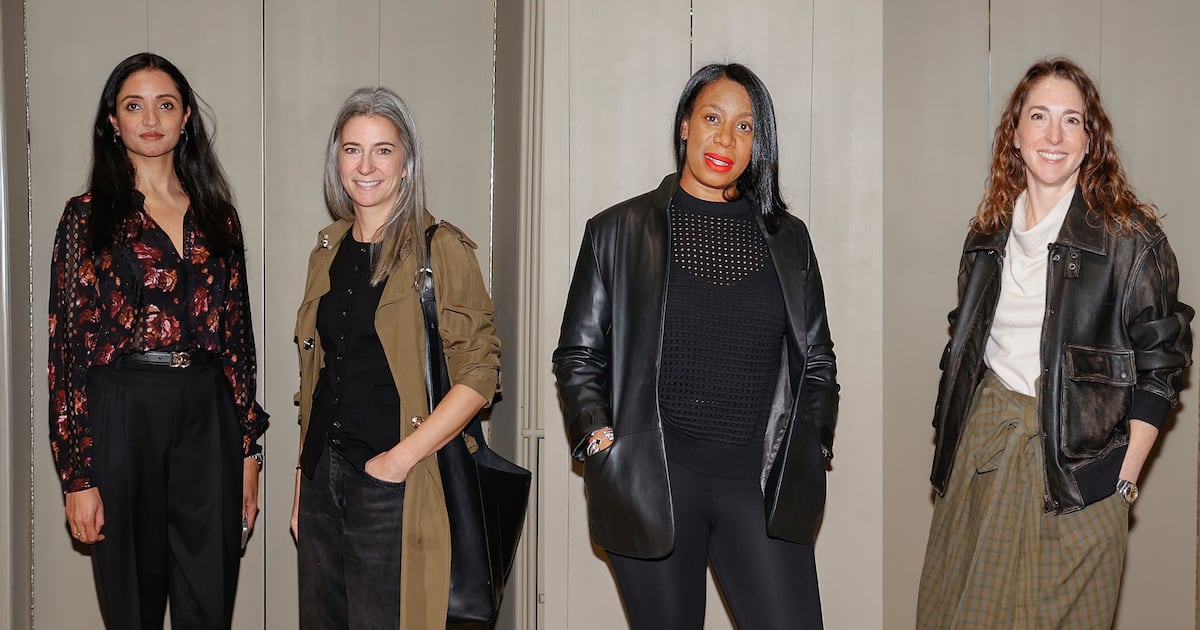NEW YORK — Last week, The Business of Fashion (BoF) and Amazon Fashion & Sports hosted an intimate roundtable discussion with industry executives on the international growth opportunities and consumer priorities they are focused on for 2026.
Abira Chatterjee, managing director of new business development at Amazon Fashion & Sports EU, Greg Baglione, head of North America strategic partnerships at Amazon Fashion, and BoF’s commercial features director Sophie Soar welcomed guests from the likes of Gap Inc., Rag & Bone, Steve Madden, Away and Cynthia Rowley at The Tusk Bar in the Evelyn Hotel.
Over an animated hour-long conversation, guests shared their learnings, challenges and strategic growth areas in a discussion hosted under the Chatham House Rule.
“The biggest growth opportunity is in Europe and the UK,” said one guest, while another emphasised EMEA at large as a broad focus. “We grew significantly this year, though we’re navigating a shifting landscape as the luxury e-commerce ecosystem consolidates.”
“We’re doing significant work to understand the right go-to-market strategy across Europe,” said another attendee. “Europe operates very differently from Latin America or Asia, so there’s substantial strategy work ahead as we evaluate our approach.”
At the start of 2025, executives surveyed by BoF and McKinsey for The State of Fashion 2025 cited consumer confidence and appetite to spend as their number one concern for the year. As brands look ahead to 2026, understanding and adapting to evolving consumer sentiment has become central to growth strategies.
Against this backdrop, consumers are recalibrating what they value in shopping experiences. According to a proprietary survey by BoF Insights and Amazon Fashion & Sports in Europe earlier this year, only 12 percent of shoppers surveyed across the UK, Germany, France, Italy and Spain (EU5) cite trendiness as a top priority, instead gravitating toward practical benefits like clear product information, sizing confidence and hassle-free returns.
Chatterjee noted this shift away from trend-chasing reflects broader retail landscape changes, observing that today’s shoppers are becoming more strategic in their fashion purchases, seeking out retailers that offer both choice and efficiency. “What matters is value, convenience and the overall service package — how easy it is to purchase and return,” she said.
Consumers are also proving increasingly channel-agonistic — caring less about where they interact with or purchase their favourite brands, and more about having access to those brands wherever it suits them. Thirty-nine percent of EU5 consumers surveyed said they begin their fashion browsing journey on multi-brand platforms.
Brands are therefore exploring new channel diversification strategies, with once strictly D2C retailers exploring wholesale avenues, partnerships and joint ventures.
Looking ahead to 2026, guests also discussed strategies for success that require balancing local market nuance with operational excellence, as well as the need to meet consumers’ shifting priorities.
Below, BoF shares anonymised insights from the discussion. Amazon’s Chatterjee and Baglione waived their right to anonymity.
Optimising Retail Presence and Operational Reach in International Markets
“The biggest growth opportunity is in Europe and the UK,” said one guest. “In certain markets, [our] brand awareness is lower — we have wholesale distribution but lack direct retail presence.”
They added how the brand’s own fulfillment infrastructure “creates challenges, with customers sometimes waiting months for products, which doesn’t meet instant gratification expectations.”
Indeed, brands will lose consumer attention if not meeting expectations around convenience. When asked how their shopping behaviour has changed in light of the current macroeconomic environment, 23 percent of frequent fashion shoppers surveyed in the EU5 say they now choose to shop with large, well-known retailers for their dependability and convenience.
“Strategic partnerships can provide the ease of access and logistics capabilities we need. We’re focused on strengthening our partner relationships with plans for significant elevation in Q3/Q4 2026,” they added.
Now we’re considering the right distribution model for each market and the right balance of brand investment versus performance marketing.
“EMEA is a huge focus, and we grew significantly this year, though we’re navigating a shifting landscape as the luxury e-commerce ecosystem consolidates,” said another guest.
“There’s a major direct-to-consumer opportunity in Europe,” they added. “For 2026, we’ve also launched a new joint venture in Latin America and plan to expand in Canada with additional stores. Asia-Pacific remains on our radar but is less of a priority. We’re simultaneously doubling down domestically across both full-price and off-price channels.”
“As we reignite our European ambitions, we’re thinking through profitable approaches,” said another guest. “Previously, we entered purely through DTC, which is very expensive. Now we’re considering the right distribution model for each market and the right balance of brand investment versus performance marketing.”
“We haven’t found the perfect balance — it’s challenging because ROI isn’t always precise — but it’s the best way to tap into localised communities,” said another guest.
Chatterjee outlined how retail partnerships can help brands navigate international expansion more efficiently, pointing to consolidated supply chain infrastructure that handles cross border compliance and logistics, as well as technology tools for demand forecasting and fit recommendations that help reduce friction in online shopping. “The whole system has to work together rather than thinking in silos,” she said.

Activate New Communities Through Authentic and Localised Engagement
“It’s about meeting consumers where they are, showing company values beyond just selling. We demonstrate that we care about what they care about by showing up with experiential moments,” said one guest in attendance. “This builds loyalty, but it also drives business — impact connects back to commercial results.”
Loyalty-driving tactics are increasingly grounded in communicating and nurturing brand values. According to Edelman’s 2024 Trust Barometer, 84 percent of people globally report the need to share values with a brand to use it.
“Our latest community activation generated significant impressions. Surprisingly, even with product giveaways, in-store sales actually increased. We’re developing metrics around conversion and traffic to understand long-term impact and replicating this model in other key markets, connecting it to retail moments like back-to-school and holiday seasons,” they added.
When we show up in communities and tap into local values — whether through local influencers or talent — brand sentiment grows and we see traffic increases in stores after events.
“When we show up in communities and tap into local values — whether through local influencers or talent — brand sentiment grows, and we see traffic increases in stores after events. We recently relaunched in a new market with a [culturally] specific activation, featuring local influencers and artists rather than tier-one celebrities. Sales in surrounding stores doubled within 48 hours because we went to where people were.”
Critically, this values alignment requires authentic localisation that reflects each community’s unique culture, priorities and voices within the markets the brand is operating. The commercial payoff of genuine community engagement — from doubled sales to increased store traffic — reflects this deeper shift in consumer expectations.
“Localisation is critical — understanding what each community actually values,” said a guest. “In one city, we featured a local artist that resonated with attendees. In another market, during a key seasonal period, we focused on services and local influencers relevant to that moment. Each element adds up.”
Chatterjee agreed, emphasising that this principle extends to operational infrastructure as well. With Amazon’s presence and leadership split across various countries, Chatterjee noted that local expertise helps brands navigate regulatory requirements and cultural nuances as they expand internationally.
Balance Universal Brand Storytelling With Channel-Specific Assortment Strategies
“Finding the balance between global and local is challenging. One recent campaign worked globally because it was [universally relevant]. But another campaign worked well domestically, but not internationally, because the cultural reference wasn’t recognised everywhere. It’s about unlocking the brand in ways that feel true while maintaining community connection,” said a guest.
“The product mix matters significantly across channels, and we have different buyers for different channels. Recently, we partnered with an influencer exclusively for one wholesale partner, using products that wouldn’t perform in our own stores. It sold out within an hour. It’s about understanding what product selection works where.”
The importance of authentic brand presence is supported by consumer sentiment, with 82 percent of EU5 shoppers surveyed agreeing that a multi-channel presence makes it easier for them to discover a brand, while 39 percent cite multi-brand retailers as their top choice for discovering new fashion. This underscores why showing up consistently across channels and communities matters for brand visibility and consideration.
Recently, we partnered with an influencer exclusively for one wholesale partner, using products that wouldn’t perform in our own stores. It sold out within an hour.
“When brands maintain their identity across geographies, customers trust them. They don’t know or care about the operational structure behind it — they assume it’s one cohesive company,” said one guest.
“What is critical for gaining trust with today’s customers is for brands to show up with a consistent story and offering across all channels, wherever customers want to interact with the brand. Consistency is paramount,” said Chatterjee, referencing campaigns, marketing assets and talent partnerships. Otherwise, “this just confuses customers. They don’t know what the brand identity is.”
Leverage AI Tools Without Sacrificing Human Touch Points
“AI’s evolution from recommendation engines to personalisation tools is exciting, but the challenge is making AI feel human — more like being understood than marketed to,” said one attendee.
Consumer expectations around personalisation are rising rapidly — 61 percent of EU5 customers surveyed see personalisation as important to their shopping experience, while 30 percent prioritise transparency and confidence through clear product descriptions, sizing confidence and flexible returns. These expectations are particularly acute in categories where fit inconsistency drives returns and customer frustration.
“Using AI to aggregate fit data across styles is particularly interesting for categories like footwear and accessories where consistency is crucial,” said another guest. “That’s where customers drop off — when sizing doesn’t meet expectations.”

Friction remains pervasive. Online cart abandonment rates reached 70 percent globally in 2024, while online returns hit $218 billion in 2023 (up from $100 billion in 2020), according to the National Retail Federation. Solving these friction points through technology has become business-critical, but only if the technology feels intuitive rather than intrusive.
Baglione pointed to conversational AI tools as one example of this balance. “Tools like Rufus and conversational AI are evolving significantly. They learn through usage and interaction, becoming increasingly sophisticated,” he said, referring to Amazon’s AI-powered shopping assistant that allows customers to ask natural language questions while browsing.
“This will become a bigger part of the customer journey for those that are AI-ready. But we’ll also continue evolving tools for those who prefer alternative methods. It’s not either-or; it’s both,” he added.
“AI is a tool, not a replacement,” agreed another guest. “We’re still creating content with real people. But there needs to be an option to connect with humans when AI doesn’t meet needs. That’s the consumer education that’s required today — AI is an enhancement, and will provide added value.”
This is a sponsored feature paid for by Amazon Fashion as part of a BoF partnership.


